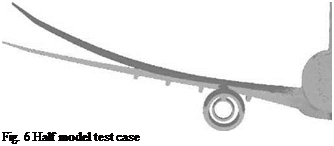Error Correction
The error correction algorithm was originally presented in [2, p. 7]. The algorithm tries to correct the а-interpolation coefficient vector locally. Therefore, unlike the previous methods, it is not using the interpolation approach including a polynomial (9), but instead the basic approach without an added polynomial (5):
n
s(x) — Хаіф (l|x-x;||) • (36)
i— 1
Furthermore, the coefficients а; are not calculated by inverting the interpolation matrix A, but instead by correcting them during the iterations continuously. In each step the interpolation error e;, і — 1 ,••, nmp of all deformation vectors
AX — { AXb Ax2,…,AXninp} (37)
at the data sites
Xinp — ^ xinp, 17 xinp!2,—7 xinp, nin^ (38)
is recalculated. The coefficients
а — (аі)І—1,:ППр (39)
and the deformation vectors Axxi are adjusted locally by the radial basis function belonging to the base point with the largest interpolation error eiworst — ||dAxiworst ||2. The correction of aiworst is performed by
^OJr’worst ф ^Q) ^^’iworst; (40)
which is used to update the interpolation values of all base points by
Axi — Axi + A aiworst Ф ( IlXi – xiworst II 2) (41)
In every step in equation (41) the error eiworst at of the deformation Axiworst is changed to zero, since
(42)
But the corrections for the deformation vectors AX*, which are located inside the impact area of the base point xiworst, are not necessarily decreasing the interpolation error. Hence, if fts, max > «inp base points should be selected, the algorithm will run infinitely without reducing the interpolation error to zero. Additionally, the algorithm "tends to show a degree of self limiting behavior in terms of how many points it uses ([…]), often returning to correct a previously identified point rather than introducing a new one" [2, p. 8].
The paper [2] uses the algorithm above to approximate the coefficients ai of equation (36), but also recommends not to use these coefficients. Instead the selected base points in Xs should be used for exact interpolation, which uses the inversion of the interpolation matrix as seen in section 2.1.1. The algorithm implemented into the deformation module presented in this document uses this recommendation and, secondly, instead of the interpolation approach (36) the approach including a polynomial as seen in equation (8) for the interpolation matrix creation.
Because the results were still not satisfactory, this approach has been combined with an initial equidistant reduction step to choose fracequi • ns, max base points by the algorithm presented in section 4.1.

A big disadvantage of the algorithm is that it only works with radial basis functions ф (r) with the maximal value for r = 0, so radial basis functions with local influence range.











